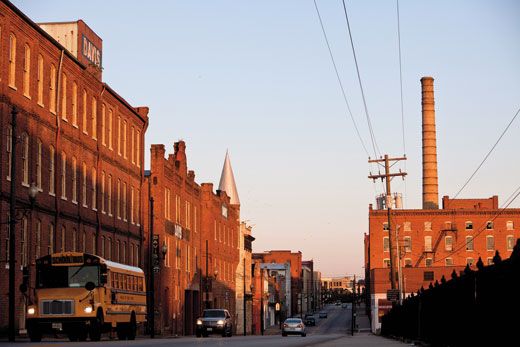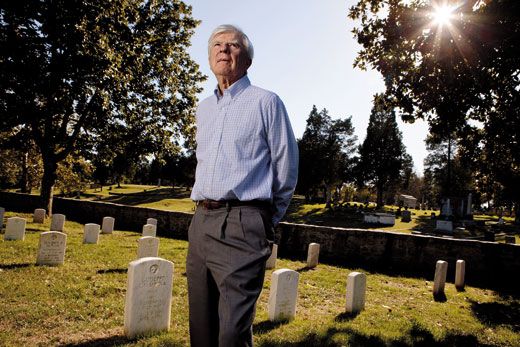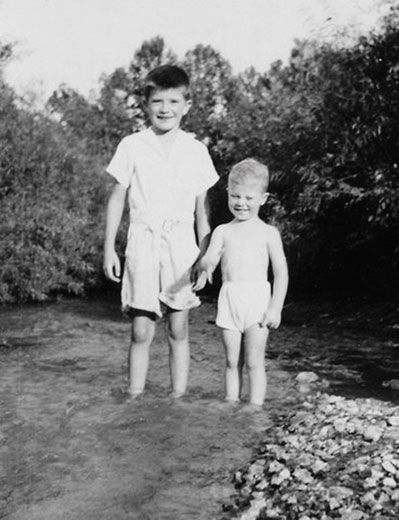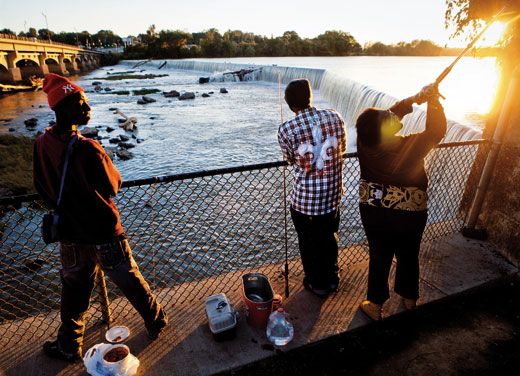Danville, Virginia: Hallowed Ground
The town’s Civil War cemeteries deepened Ernest Furguson’s view of history as a young boy
/https://tf-cmsv2-smithsonianmag-media.s3.amazonaws.com/filer/MKOT-Danville-VA-Ernest-Furgurson-631.jpg)
I grew up on Lee Street in Danville, Virginia, the last capital of the Confederacy, and I attended Lee Street Baptist Church and Robert E. Lee School, where I played the role of General Lee in our fifth-grade pageant much more convincingly than Martin Sheen did in the film Gettysburg.
Lee was the street of my boyhood, my paper route, my deepest roots. It was lined with glowing maples, and we seldom had to interrupt our ball games to let a streetcar pass. The house that my grandfather built in 1909 faced the juncture of two cemeteries. To the left ran the stone wall around the Danville National Cemetery, which everyone called the Yankee cemetery, because that’s where Union soldiers who died in the local tobacco warehouse prisons during the Civil War were buried. To the right was the white picket fence that enclosed Green Hill, where my parents, grandparents and some of my great-grandparents are buried, and soon enough I will be too.
For us, those cemeteries were park and playground; our parents had courted there; we knew every oak and cedar, dove and chipmunk. On a mound at the center of the Yankee cemetery was a 70-foot flagpole flying the 48-star Old Glory. Around it were black-painted cannon barrels set in concrete, and pyramids of cannonballs left over from the Civil War. Spread across the surrounding acres were more than 1,300 graves marked by government-issue headstones. Every Memorial Day, black citizens wearing patriotic sashes paraded there to hear music and speeches honoring the soldiers who had died to make them free. Yet within that cemetery, beside the back wall, a few dozen U.S. Colored Troops—free blacks and former slaves who had fought for the Union—were segregated in death as they had been in life. Later, when veterans of the Spanish-American War and World War I were laid beside the Civil War dead, we kids, barefooted in season, stood at attention wherever we were as the neighborhood echoed the bugle notes of taps.
That stone wall around the National Cemetery marked the boundary between Yankee and Rebel territory more clearly than the Potomac River ever did. From the main gate of Green Hill, a road ran back to the Confederate Soldiers Monument, a granite obelisk on a mound surrounded by Virginia cedars. It was decorated with bronze bas-relief images of Robert E. Lee and Stonewall Jackson, and words chosen by the Ladies’ Memorial Association, which raised $2,000 to erect it in 1878: “Patriots!” it said. “Know that these fell in the effort to establish just government and perpetuate constitutional liberty. Who thus die will live in lofty example.” And on another side: “They died as men who nobly contend for the cause of truth and right. ‘They softly lie and sweetly sleep.’”
Scattered among the winding lanes were dozens, perhaps hundreds, of Confederate veterans’ graves, including that of Pvt. Harry Wooding, honorarily promoted to Cap’n Harry after the War, who was mayor of Danville for 46 years. We boys stood reverently at the edge of the crowd at his funeral in 1938. Many of those veterans’ graves were marked with footstones bearing the initials CV (for Confederate Veteran); at one time such a stone marked the grave of my mother’s grandfather, Robert Daniel Ferguson, first sergeant of the Chatham Grays, Company I, 53rd Virginia Infantry. But through the years most of those markers were broken off and lost. I was told that my great-grandpa lay somewhere near the fence across from the church, but nobody knew exactly where.
Behind the National Cemetery was a third burial ground, set apart after the War for newly emancipated slaves. Nice folks called it the “colored cemetery.” I didn’t know then that its proper name was Freedman’s. In decades past, some black families had erected walls about plots there, with imposing gravestones. But these symbols of status had been effectively erased by municipal neglect. The stones stood in a nine-acre wasteland. The border between Freedman’s and Green Hill, though only two strands of barbed wire, was as distinct as the wall around the National Cemetery: on the west side, well-mowed lawn; on the east, tall weeds. We got cockleburs and sticktights on our socks when we passed through on our way to catch frogs and crawfish in Jackson Branch.
To get there, we crossed the main line of the Southern Railway, which ran from Washington to New Orleans, and the other way for Southerners hoping to find jobs during the Great Depression or respect during the long grim decades of segregation. Often when trains slowed approaching the station by the Dan River, hobos hopped off and spread through the neighborhood, asking for food. When a coal train eased down the grade, black men climbed on and threw off chunks to women alongside, who filled guano sacks to take home to heat their stoves on Liberty Hill.
Like Freedman’s Cemetery, Liberty Hill was populated first by newly emancipated slaves after the War. It was a poor ghetto of frame houses and shacks beyond Jackson Branch. You crossed the stream on a single wooden girder; if you grabbed the cable handrail alongside, you might get rusty metal splinters. This bridge led to a sweet spring, a two-inch pipe jutting out of the red clay hillside, that had provided water to Liberty Hill for generations. Beside the branch, in a hut of discarded signs and tar paper, lived Old Mary, who came to Slick Warren’s grocery store to scavenge unsold vegetables and carry them home in her sack. She said she wanted them to feed her pig, but we understood she was feeding herself, too. She wore what seemed the same long skirt, apron and bandanna year-round, and leaned over to sift through the garbage at an acute angle that reminded me of slaves picking tobacco in pictures I had seen. We told ourselves that as a child, she had been a slave herself.
It’s hard to explain how close 1865 was to us, how reminders of that war still surrounded us, so long after Appomattox. Danville was not Richmond, whose obsession and main topic of conversation was its vanished glory. It was not girded by battlefields, had not burned when the Yankees came. True, Jeff Davis stayed in Danville for a week after fleeing Richmond that April, making it the last capital of the Confederacy and the mansion where his cabinet met the last capitol. But when Union regiments arrived two weeks later, the mayor surrendered the town calmly, and when the soldiers left, the town fathers thanked them for behaving so politely.
Possibly in some other place, after some other war, all that would have faded away. But there we were at Robert E. Lee School two generations later, singing the songs of Stephen Foster—“Beautiful Dreamer,” “Old Black Joe,” “Jeanie with the Light Brown Hair”—as if waiting for the Chatham Grays and the Danville Artillery to come home. There we were, studying a fifth-grade Virginia history book that chose Thomas Nelson Page, son of a Confederate major, to tell us how he saw the old plantations.
“I believe it was the purest and sweetest life ever lived,” the textbook quoted him as saying. “It gave the most to make this great nation....This same social life brought Christ to the Negroes in less than two hundred years and a civilization which they had not known since the dawn of history. It made men noble, gentle, and brave and women tender and true.”
Yes, we were brainwashed, but I don’t think any of us were persuaded that slavery had been a paradise. We could see its legacy in the lives of the black people around us—see it, if not, at that age, fully comprehend it. What sank into me was not so much what I was taught in history class as what I unconsciously absorbed from the ground I walked on, from the long rows of mute stone testimony to the deaths of so many, and from the sad voices of old ladies whose fathers had been in the War. It was there before I went out into the world, and eventually it compelled me to write about that war—not just the generals and battles, but the hospitals and cemeteries, the widows and lonesome children. When I go back to Danville and Lee Street, in person or in my mind, I understand myself better, with all my guilts and complexes. That quarter-mile square of my barefoot days, its tangible reminders of soldiers and slaves, rights and wrongs, playmates and ancestors, life and especially death, has somehow affected everything I’ve thought and written.
Things have changed, of course. What were broad aisles between the original graves in the National Cemetery are now filled with veterans of World War II, Korea and Vietnam. A grand magnolia tree that wasn’t there when I was young has grown up and displaced the headstones of three soldiers from Ohio, Indiana and Wisconsin—Yankees now as deeply rooted in Virginia as I am. The white pickets around Green Hill have become a chain-link fence; scattered gravestones there have been overturned by vandals. The Daniel house at 738 Lee, where my maternal great-grandmother sat on the porch waiting to join her soldier husband across the street, has been torn down. I have found the plot where the two of them are buried, and marked it with a government tombstone like those that identify the Union soldiers a few hundred yards away. Danville has had three black mayors; the barbed wire between Green Hill and Freedman’s cemeteries is gone; and the grass is mowed on both sides. Lee Street Baptist Church is now Mount Sinai Glorious. Liberty Hill has city water, paved streets and middle-class housing.
Changed indeed. I doubt that the town’s younger generations could understand what it was like for us so long ago, the feeling that we somehow shared the glories and the lost causes of those on both sides of that stone wall. Too much more history has happened since. Yet even from this distance, I still hear the echo of taps.
Ernest B. “Pat” Furgurson’s most recent Civil War book is Freedom Rising.
/https://tf-cmsv2-smithsonianmag-media.s3.amazonaws.com/accounts/headshot/DSCN0003-001.JPG)




/https://tf-cmsv2-smithsonianmag-media.s3.amazonaws.com/accounts/headshot/DSCN0003-001.JPG)